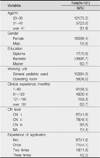Abstract
Purpose
The purpose of this study was to investigate how nurses perceive the Career Ladder System(CLS).
Methods
This study was a descriptive survey using questionnaires. Questionnaires were developed by an expert group. Participants included 161 nurses working in the Children's Hospital. The data were analyzed using factor analysis, Cronbach's alpha, descriptive statistics, χ2-test and ANCOVA.
Results
This study revealed that nurses who advanced in their career ladders have a significantly higher perception of participation in their professional activities and a general comprehension of the CLS more than the nurses who did not advance in their career ladders. However, nurses who advanced in their career ladders have a significantly lower perception of the expected outcome of the CLS more than nurses who did not.
Figures and Tables
References
1. Benner P. From novice to expert: Excellence and power in clinical nursing practice. 1984. California: Addison-Wesley Pub.
2. Buchan J. Evaluating the benefits of a clinical ladder for nursing staff: An international review. Int J Nurs Stud. 1999. 36(2):137–144.

3. Byun DS, Yom YH. Factors affecting the burnout of clinical nurses-focused on emotional labor. J Korean Acad Nurs Adm. 2009. 15(3):444–454.
4. Fusilero J, Lini L, Prohaska P, Szweda C, Carney K, Mion LC. The career advancement for registered nurses excellence program. J Nurs Adm. 2008. 38(12):526–531.
6. Korean Hospital Nurses Association. The business report year of 2009. 2010. 02. Seoul: Author.
7. Kwon IG, Sung YH, Park KO, Yu OS, Kim MA. A study on the clinical ladder system model for hospital nurses. Clin Nurs Res. 2007. 13(1):7–23.
8. Lee HS, Lim JH. SPSS 12.0 mannual for method and interpretation of statistical analysis. 2007. Seoul: Bupmunsa.
9. Nelson JM, Cook PF. Evaluation of a career ladder program in an ambulatory care environment. Nurs Econ. 2008. 26(6):353–360.
10. Nelson JM, Sassaman B, Phillips A. Career ladder program for registered nurses in ambulatory care. Nurs Econ. 2008. 26(6):393–398.
11. Nunnally J. Psychometric therapy. 1978. New York: Mc Graw-Hill.
12. Park SH, Park KO, Park SA. A development of career ladder program. J Korean Acad Nurs Adm. 2006. 12(4):624–632.
13. Riley JK, Rolband DH, James D, Norton HJ. Clinical ladder nurse's perception and satisfiers. J Nurs Adm. 2009. 39(4):182–188.




 PDF
PDF ePub
ePub Citation
Citation Print
Print







 XML Download
XML Download